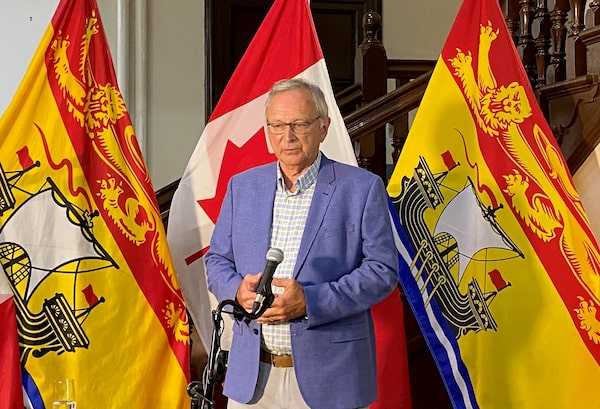
New Brunswick Premier Blaine Higgs speaks to media during a press conference in Fredericton on July 30, 2020.Kevin Bissett/The Canadian Press
The New Brunswick government has informed a Mi’gmaq nation on the Quebec side of the provincial boundary that their students are no longer welcome to attend high school in New Brunswick, as the province tightens the Atlantic bubble.
More than 100 students from the Listuguj Mi’gmaq First Nation, along with the rest of the students in Sugarloaf High School in Campbellton, N.B., were kept home Friday after a staff member tested positive for COVID-19. The school will be closed for several days while it is disinfected and while contact tracers work on the case.
Listuguj Chief Darcy Gray says New Brunswick officials informed him that school would resume Thursday, but without his Indigenous students, who are not considered essential travellers allowed to cross the provincial boundary. They will now study online when their Campbellton classmates head back to school.
“I don’t know how you can send First Nations kids home and keep other kids in school and think that’s OK,” Mr. Gray said in an interview. “That’s a tough one to understand. It’s not a good message we’ve been sent here and it’s not sitting well.”
A handful of communities along the Quebec-New Brunswick boundary are twin towns sharing services and family ties. Additionally, the area of Northern New Brunswick is traditional Mi’gmaq land. “Some of the people now denying us access have been known to give the land acknowledgement about it being unceded Mi’gmaq territory,” Mr. Gray said. “It’s unfathomable and makes zero sense.”
While Quebec has been Canada’s COVID-19 hot spot since the start of the pandemic, New Brunswick has had 238 cases. But the province is tightening measures in the Moncton and Campbellton regions after recent outbreaks. The tighter boundary restrictions will only allow passage into New Brunswick without 14 days isolation to those seeking essential services, which include medical care and businesses such as grocery stores.
New Brunswick announced 13 new cases Friday while Quebec had 1,102 new cases. “The numbers outside our borders are not good and continue to increase,” said Dr. Jennifer Russell, New Brunswick’s chief medical officer of health on Friday.
In announcing that the Indigenous students would move online after other students return to school, Premier Blaine Higgs said he recognizes the “strong bonds on both sides of the Restigouche River” and promised to work with the First Nation and other communities “to help make sure everyone is safe and has access to the things they need.”
In March, New Brunswick closed travel to all but essential services such as medical care, but almost all Canadian schools were closed then. The province loosened rules in August before cracking down again this week.
None of the 4,104 members of the Listuguj community have been infected, Mr. Gray said, adding that they have had mandatory masks and customer registration at stores and other businesses throughout the pandemic. “We’ve been COVID-19-free from the beginning and we’ve worked hard to keep everything under control because we know we are the ones who are labelled the risk,” Mr. Gray said.
The First Nation has 13 educators who work at the Campbellton school who will now organize “learning pods” for the high-school students in a Listuguj training centre.
Other boundary communities are also facing hardships from the crackdown on interprovincial travel. Pascal Bujold, mayor of Pointe-à-la Croix, which completes the small triangle with Listuguj and Campbellton, said New Brunswick’s shifting restrictions and requirements have been difficult but the most recent crackdown is “quite a shocker.”
“It’s creating quite a lot of friction and anger in the community,” said Mr. Bujold, whose mother lives across the river in Dalhousie. He will no longer be able to visit her, but he was able to cross the river to do banking Friday at noon. “We’re all in this together and the bubble needs to stay open.”
One week ago, Quebec installed checkpoints to isolate Pointe-à-la-Croix and Listuguj from the rest of Quebec in a failed attempt to assuage New Brunswick and preserve the community links. “We’re getting pushed around by a province of 600,000,” former Parti Québécois interim leader Pascale Bérubé said in the National Assembly Thursday after New Brunswick announced the crackdown.
Mr. Bujold said he might seek help from the federal government, which has been reluctant to get involved in the provincial boundary checkpoints that have popped up in several parts of Canada since March. “I’m reluctant to throw much more wood on the fire, it’s hot enough already,” he said.
In August, a Newfoundland Superior Court judge ruled that movement restrictions on interprovincial travel are a reasonable limit on the right to free movement in the time of a pandemic.
Joanna Baron, executive director of the Canadian Constitution Foundation, a legal charity dedicated to using constitutional rights to limit expansion of government power, said she expected judges would be “highly deferential to provincial governments” during a pandemic. And, she added, “Ottawa doesn’t have the appetite or capacity to do anything about it.”
But, she said, the boundary restrictions infringe on freedom of movement, stray into federal jurisdiction controlling interprovincial commerce, and may also infringe rights of Indigenous self-governing people. “But on top of it all, it’s just rubbing salt in their wounds,” she said.
Our Morning Update and Evening Update newsletters are written by Globe editors, giving you a concise summary of the day’s most important headlines. Sign up today.